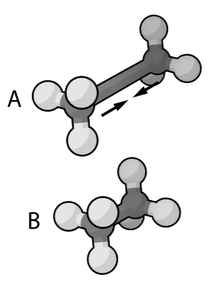| Original author(s) | Peter Kollman, Version1: +Paul Weiner. Version 2: + U Chandra Singh; V3. + David Pearlman, James Caldwell, William Ross, Thomas Cheatham, Stephen Debolt, David Ferguson, George Seibel; Later versions: David Case, Tom Cheatham, Ken Merz, Adrian Roitberg, Carlos Simmerling, Ray Luo, Junmei Wang, Ross Walker |
|---|---|
| Developer(s) | University of California, San Francisco |
| Initial release | 1981 |
| Stable release | Amber23, AmberTools23[1]
/ April 21, 2023 |
| Written in | C, C++, Fortran |
| Operating system | Windows, OS X, Linux, Unix, CNK |
| Platform | x86, Nvidia GPUs, Blue Gene |
| Size | Varies |
| Available in | English |
| Type | Molecular dynamics |
| License | Amber: Proprietary AmberTools: GPL, public domain, other open-source |
| Website | ambermd |

Assisted Model Building with Energy Refinement (AMBER) is the name of a widely-used molecular dynamics software package originally developed by Peter Kollman's group at the University of California, San Francisco. It has also, subsequently, come to designate a family of force fields for molecular dynamics of biomolecules that can be used both within the AMBER software suite and with many modern computational platforms.
The original version of the AMBER software package was written by Paul Weiner as a post-doc in Peter Kollman's laboratory, and was released in 1981.[2]
Subsequently, U Chandra Singh expanded AMBER as a post-doc in Kollman's laboratory, adding molecular dynamics and free energy capabilities.
The next iteration of AMBER was started around 1987 by a group of developers in (and associated with) the Kollman lab, including David Pearlman, David Case, James Caldwell, William Ross, Thomas Cheatham, Stephen DeBolt, David Ferguson, and George Seibel.[3] This team headed development for more than a decade and introduced a variety of improvements, including significant expansion of the free energy capabilities, accommodation for modern parallel and array processing hardware platforms (Cray, Star, etc.), restructuring of the code and revision control for greater maintainability, PME Ewald summations, tools for NMR refinement, and many others.
Currently, AMBER is maintained by an active collaboration between David Case at Rutgers University, Tom Cheatham at the University of Utah, Adrian Roitberg at University of Florida, Ken Merz at Michigan State University, Carlos Simmerling at Stony Brook University, Ray Luo at UC Irvine, and Junmei Wang at University of Pittsburgh.
- ^ Amber 2023 Reference Manual
- ^ Weiner, Paul K.; Kollman, Peter A. (1981). "AMBER : Assisted model building with energy refinement. A general program for modeling molecules and their interactions". Journal of Computational Chemistry. 2 (3): 287–303. doi:10.1002/jcc.540020311. ISSN 0192-8651.
- ^ Pearlman, David A.; Case, David A.; Caldwell, James W.; Ross, Wilson S.; Cheatham, Thomas E.; DeBolt, Steve; Ferguson, David; Seibel, George; Kollman, Peter (1995). "AMBER, a package of computer programs for applying molecular mechanics, normal mode analysis, molecular dynamics and free energy calculations to simulate the structural and energetic properties of molecules". Computer Physics Communications. 91 (1–3): 1–41. doi:10.1016/0010-4655(95)00041-d. ISSN 0010-4655.